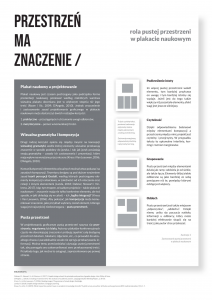Avant, wol. XIII, nr 3, https://doi.org/10.26913/avant.3202217
publikowane na licencji CC BY-NC-ND 3.0
Karolina Polasik
Uniwersytet Kazimierza Wielkiego w Bydgoszczy
karolina.polasik.sztuka@gmail.com
Przyjęto 15 listopada 2023; zaakceptowano 28 grudnia 2022; opublikowano 9 marca 2023.
Pełny tekst
Abstrakt: Zrozumienie i zastosowanie zasad projektowania graficznego w plakacie naukowym może dostarczyć korzyści praktycznych, takich jak przyciągnięcie i utrzymanie uwagi odbiorców, a także korzyści merytorycznych, czyli pomocy w komunikowaniu treści. Te drugie opierają się między innymi na koncepcji wizualnej gramatyki (opisanej przez Kress i Van Leeuwen [2006] i zastosowanej do analizy plakatu naukowego przez D’Angelo [2010]), wedle której elementy wizualne przekazują znaczenie w sposób podobny do języka, i tak jak język posiadają swoją gramatykę: zasady ich zastosowania i prezentacji, które mają wpływ na wyrażany przez nie sens. Poster pokazuje zastosowanie wizualnej gramatyki w plakacie naukowym na przykładzie jednego z elementów wizualnych plakatu, który często jest niedoceniany: pustej przestrzeni.
Słowa kluczowe: plakat konferencyjny; wizualna gramatyka; przestrzeń negatywna; wizualizacja w nauce; projektowanie graficzne
Space Matters. The Role of Empty Space in Conference Posters
Abstract: Understanding and applying the rules of graphic design in conference posters can provide: practical benefits, such as attracting and maintaining attention of viewers, and substantive benefits supporting and enriching communicated content. This second kind of benefits is based on the concept of visual grammar (described by Kress & Van Leeuwen [2006] and applied to scientific poster by D’Angelo [2010]), according to which visual elements express meaning similarly to language, and just like language they have their grammar – rules of application and presentation impacting the expressed sense. This poster presents the use of visual grammar in conference posters using the example of an often underappreciated visual element – empty space.
Keywords: conference poster; visual grammar; negative space; visualisation in science; graphic design
Bibliografia
| Cook, M. P. (2006). Visual representations in science education: The influence of prior knowledge and cognitive load theory on instructional design principles. Science education, 90(6), 1073-1091. https://doi.org/10.1002/sce.20164 |
||||
| Dabner, D., Stewart, S. i Vickress, A. (2017). Graphic design school: the principles and practice of graphic design. John Wiley & Sons. | ||||
| D’Angelo, L. (2010). Creating a framework for the analysis of academic posters. Language Studies Working Papers, 2, 38-50. | ||||
| Gosling, P. J. (2012). Scientist’s guide to poster presentations. Springer Science & Business Media. | ||||
| Hoyningen-Huene, P. (2013). Systematicity: The Nature of Science. Oxford University Press, USA. https://doi.org/10.1093/acprof:oso/9780199985050.001.0001 |
||||
| Kress, G. (2009). Multimodality: A social semiotic approach to contemporary communication. Routledge. | ||||
| Kress, G. i Van Leeuwen, T. (2006). Reading images: The grammar of visual design. Routledge. https://doi.org/10.4324/9780203619728 |
||||
| Landa, R. (2018). Graphic design solutions. Cengage Learning. | ||||
| Lidwell, W., Holden, K. i Butler, J. (2010). Universal principles of design, revised and updated: 125 ways to enhance usability, influence perception, increase appeal, make better design decisions, and teach through design. Rockport Pub. | ||||
| Murchie, K. J., i Diomede, D. (2020). Fundamentals of graphic design – essential tools for effective visual science communication. Facets, 5(1), 409-422. https://doi.org/10.1139/facets-2018-0049 |
||||
| Patience, G. S., Boffito, D. C. i Patience, P. (2015). Communicate science papers, presentations, and posters effectively. Academic Press. | ||||
| Pedwell, R. K., Hardy, J. A. i Rowland, S. L. (2017). Effective visual design and communication practices for research posters: Exemplars based on the theory and practice of multimedia learning and rhetoric. Biochemistry and Molecular Biology Education, 45(3), 249-261. https://doi.org/10.1002/bmb.21034 |
||||
| Rodríguez Estrada, F. C. i Davis, L. S. (2015). Improving visual communication of science through the incorporation of graphic design theories and practices into science communication. Science Communication, 37(1), 140-148. https://doi.org/10.1177/1075547014562914 |
||||
| Rowe, N. i Ilic, D. (2009). What impact do posters have on academic knowledge transfer? A pilot survey on author attitudes and experiences. BMC medical education, 9(1), 1-7. https://doi.org/10.1186/1472-6920-9-71 |
||||
| White, A. W. (2011). The elements of graphic design: space, unity, page architecture, and type. Skyhorse Publishing, Inc. | ||||


